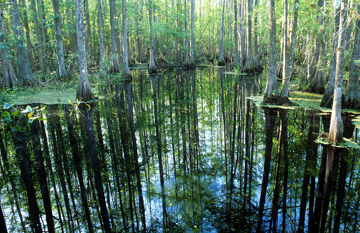Not long after Hurricane Katrina slammed into the Gulf Coast, a local fisherman found an especially good fishing spot off the coast of Alabama. Suspecting that something unusual was going on, he brought out a diver, who found an underwater enchanted forest — giant logs and stumps from an ancient stand of bald cypress. Today, scientists are scrambling to study the forest before it’s destroyed by wood-eating creatures and the Gulf waters.
 An underwater bald cypress forest was discovered in the Gulf of Mexico after Hurricane Katrina. Credit: U.S. Forest Service
An underwater bald cypress forest was discovered in the Gulf of Mexico after Hurricane Katrina. Credit: U.S. Forest ServiceScientists got their first peek at the forest in 2012, and reported its presence the following year. It covers about half a square mile, and is about 60 feet below the surface.
Early carbon-dating tests show that the trees are about 50,000 years old — a potential bonanza for scientists who study ancient climates. Individual trees could have lived for a thousand years or more, so their rings should preserve a long record of conditions during an ancient Ice Age.
About 50,000 years ago, so much water was frozen in glaciers that global sea level was much lower than it is today, so the coastline extended farther outward. As the climate warmed and sea level rose, the forest was submerged, then buried beneath a layer of sediments. But Katrina washed away the covering silt, once again exposing the forest.
Today, it acts as a reef system, attracting fish and other life — including critters that eat wood. Oxygen in the water will help those critters decompose the wood. So scientists are trying to study the forest before it once again disappears — this time, for good.
This episode of Science and the Sea was made possible by Texas Sea Grant.

